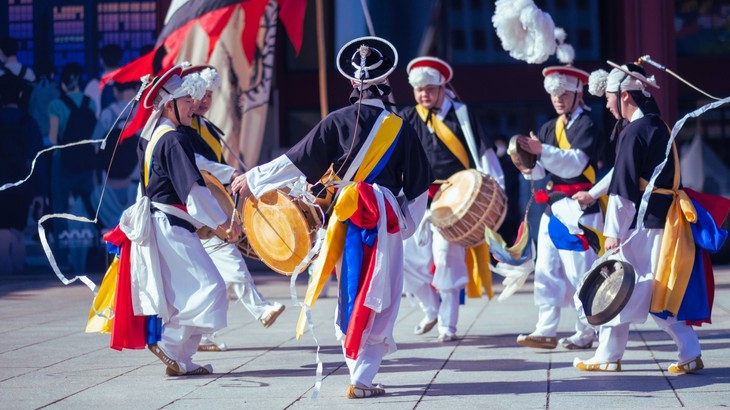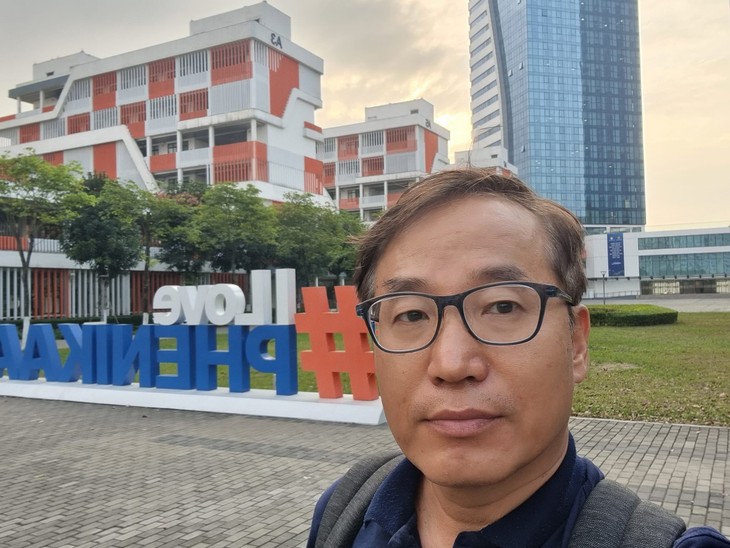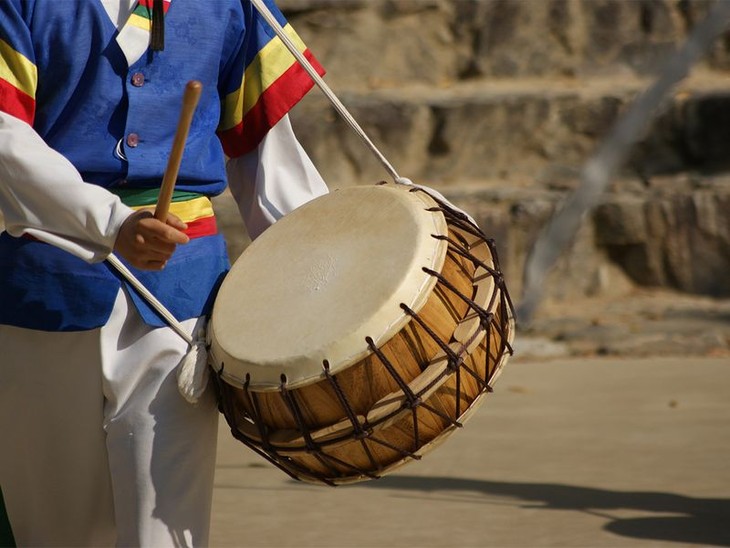(VOVWORLD) - South Korea is a modern country, but it still preserves its traditional values. One well-preserved traditional value is Samulnori, a four-person percussion ensemble characterized by complex driving rhythms, a colorful dance, and intense energy. For hundreds of years this folk dance has represented the agricultural lifestyle of the Korean people during the Joseon period from the 14th to 19th century. We invite you to discover this unique Korean folk dance art.
 Samulnori performance (Photo: koreattrack.com) Samulnori performance (Photo: koreattrack.com)
|
Shin Sung Buk, who teaches Korean at the Phenikaa University, Hanoi, told VOV that Samulnori is an important cultural artefact that represents Korea’s traditions and history. “Samulnori is a traditional music genre of Korea performed by four percussion instruments – the buk drum, a double-ended drum called the janggu, the jing, and the ggwaenggari. It’s time for us to revive its importance and promote its ranking in the world. We hope audiences will feel the charm of Samulnori and take the time to get to know it,” Shin Sung Buk noted.
 Shin Sung Buk, a Korean teacher of the Phenikaa University, Hanoi (Photo credit: Shin Sung Buk ) Shin Sung Buk, a Korean teacher of the Phenikaa University, Hanoi (Photo credit: Shin Sung Buk ) |
Meanwhile, Le Ngoc Diep, an editor in the Korean section of VOV’s Overseas Service, recalled the first time she saw a Samulnori performance, she found it exciting and similar to the gong culture of the Ede ethnic group in Vietnam.
“I would like to see more Samulnori performances in Vietnam, so that Vietnamese people can get to know Korean art and culture,” Diep added.
 Le Ngoc Diep, an editor in VOV's Korean section (Photo credit: Ngoc Diep) Le Ngoc Diep, an editor in VOV's Korean section (Photo credit: Ngoc Diep) |
The genre depicts the agricultural life of the Korean people during the Joseon Dynasty from 1392 to 1910. It prays for favorable weather and bumper harvests and for relief from evil spirits and the monotony and burden of daily hard labour.
In Korean, the words “sa” and “mul” together mean “four things” and “nori” means “to play”. “Samulnori” refers to the ensemble of four musicians who perform and dance with four percussion instruments.
Yeon Jae-ho, a member of the National Orchestra of Korea and a Samulnori mentor, said each instrument symbolizes an element of nature. He explained in details, “The four instruments – kkwaenggwari, jing, janggu, and buk – symbolize thunder, wind, rain, and cloud. In contrast to Western musical percussion methods, in Samulnori the left and right hands have different roles, and the direction of striking is often sideways rather than up and down. You must breathe appropriately for the rhythm without stopping.”
Jae-ho said all the weather phenomena that occur when it rains are recreated in a Samulnori performance. The wind blows and dark clouds appear. Then the rain starts to fall and the thunder sounds. Singing is an essential part of a Samulnori performance.
According to Jae-ho, the buk drum is the soul of the Samulnori performance, adding, “The buk drum provides the basic framework of the rhythm. It’s played in a similar manner to the ggwaenggari, but the number of rhythms is relatively small and it requires a lot of strength.”
“The body movement is vivid. You have to use your body as well as your arms. The drum produces low notes and requires a lot of energy and endurance. The rhythm is not complicated, but it draws a big picture and maintains a steady feeling, giving power to the music. It sounds much better when you place it on your foot and beat it,” said Jae-ho.
 Buk is a barrel shaped drum with a lower pitch. (Photo: Image Credit: Shutterstock) Buk is a barrel shaped drum with a lower pitch. (Photo: Image Credit: Shutterstock)
|
Samulnori artists play their musical instruments while dancing and shaking their heads on which they wear conical hats tied with a long string.
Samulnori is known worldwide as music that originated in Korea, but it’s not as old as many people think. In fact, it was first introduced about 40 years ago.
Samulnori performances used to be held only outdoors, but in 1978 it was brought inside for the first time. The dancing was simplified for indoor performance and a more modern sensibility was incorporated, resulting in today's Samulnori. Innovative young musicians have added electronic music to the intense beats and melodies of Samulnori.
In 2014, Samulnori was recognized by UNESCO as an intangible cultural heritage of humanity.